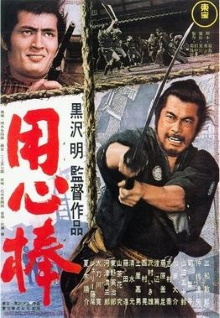
We’re back to the classic Akira Kurosawa samurai film with this one. It’s full of the director’s favorite actors including of course Toshiro Mifune in the lead role and indeed the shot of him slowly striding down an empty street is one of the director’s most iconic images. The plot is comparatively simple but this characterization of a wandering samurai out to do good deeds through both guile as well as force of arms has been an influential one for good reason.
A small town is torn apart by fighting between two rival criminal gangs, each backed by a different local businessman. However as their forces are more or less evenly matched, they are reluctant to engage in an all out battle. A wandering ronin arrives and decides to shake things out. He calls himself Sanjuro and proves his prowess by confronting the minions of one of the two leaders, Ushitora, and casually kills three of them. The other boss Seibei naturally offers him a great deal of money to fight for him but this upsets both his wife and his next most skilled fighter who complains about being paid too little and leaves. Seibei placates his wife by saying that he plans to kill Sanjuro after he wins to get his money back but Sanjuro eavesdrops on them. Bolstered by Sanjuro’s presence, Seibei’s forces attack but Sanjuro resigns before the fighting starts and gives the money back, announcing that he knows about the impending betrayal. During the fighting, many of the thugs on both sides die and Sanjuro is happy but then a government official arrives and the two sides make peace. So Sanjuro tries to think of another scheme to get them to fight again.
This is another one of those films that possess a very stage theatrical quality, being basically set only on the main street of the town where the two gangs keep confronting each other and the highly exaggerated and stylized performances of the gangsters. It is however wonderfully staged and choreographed and it is amazing how the gangster characters fall into familiar archetypes that wouldn’t feel out of place in modern anime. As usual with Kurosawa, the actual fighting consists of very brief bursts of violence as Sanjuro requires only a single slash to kill each enemy. But there is always plenty of posturing and drama before and after the fighting. So we have the gangsters try to work up their courage to actually fight by staying together and moving as a group and taunting their enemies and shying away just before contact like a big pack of dogs. This film also mixes things up by having Ushitora’s brother being armed with a pistol which he flaunts and uses to terrorize everyone else as it kills with a single shot. It is very different from Hollywood, or indeed any other modern fight scenes, but it is both beautiful and works very well.
I am a little disappointed in that the main character truly is an unstoppable badass. I think it would have been a more interesting film if he relied more on guile rather than brawn to beat the gangs. Plus his deceptions and misdirections are laughably simple and rely on the gangsters being cartoonishly dumb or greedy to work. As it is, he is shown to be such a peerless swordsman that it seems like he could just mow down them all down without much trouble. Still at one point the enemies catch him without his sword and without it he is just as vulnerable as anyone else.
This is widely considered one of Kurosawa’s best films and indeed one of the greatest films ever made. To me, it’s a film that holds up perfectly despite its age and is just plain fun to watch. But I think it’s claim to true greatness lies more in the enduring influence of its camera shots, staging and character archetypes. For example it is very noticeable how the characters like to keep their arms inside their clothes and slip them out into their sleeves only when needed. Visual quirks like this still show up in anime. Plus of course this character was so popular that Kurosawa made another film with him and it spawned countless imitators.